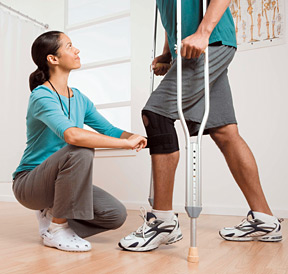Steps to Successful Rehabilitation
Don't Let a Sprain/Strain Injury Keep You on the Sidelines
By Dr. K. Jeffrey Miller
Soft-tissue injuries are just that: injuries involving the soft tissue of the body - non-bone tissues that surround and connect structures and organs -and we've all experienced this type of injury before.
Muscle and ligament sprains and strains are common soft-tissue injuries, and while they may seem minor, they often cause significant pain and disability.
It's important to have a basic understanding of soft-tissue injuries for several reasons. First, they happen frequently. Second, when an injury does occur, it helps to know the fundamentals of rehabilitation/recovery so you and your doctor can work together to achieve proper healing in the shortest, safest amount of time. This understanding will help in all aspects of rehabilitation including stretching, aerobic exercise and strength training.
Sprains are injuries (tears) of ligaments. Strains are injuries (tears) of muscles and/or their tendons. Both develop from macrotrauma and/or microtrauma to the tissues. Macrotrauma is a more sudden and violent type of injury that results in significant tearing of tissues. Microtrauma results in small tears over a period of time. Either way, the healing process for the tissues will be the same.
Essential Elements of Successful Rehabilitation
 1. Warming Up, Stretching and Cooling Down
1. Warming Up, Stretching and Cooling Down
Three fitness activities that are often minimized or completely overlooked: warming up, stretching and cooling down. While they are often considered important for working out or training, they are also vital to the overall rehabilitation process. Whether recovering from an injury or just training for a sport, many people skip these activities and go straight to their primary workout, which is a big mistake.
 The activities are slow, tedious, and they do prolong an exercise session. For those who are already less than thrilled to be exercising, warming up, stretching and cooling down are not popular. However, the importance of these activities cannot be overlooked. They have specific functions and aid in the success of any exercise/rehabilitation program, regardless of the goals and intensity of the program.
The activities are slow, tedious, and they do prolong an exercise session. For those who are already less than thrilled to be exercising, warming up, stretching and cooling down are not popular. However, the importance of these activities cannot be overlooked. They have specific functions and aid in the success of any exercise/rehabilitation program, regardless of the goals and intensity of the program.
Warming Up
There are two types of warm-ups: general and specific. General warm-up is for the entire body and is not the focus of a particular event or sport. In patient rehabilitation, general warm-up is preferred and is typically achieved by walking, jogging slowly or riding a stationary bicycle. Five to 10 minutes of one of these activities readies the patient/athlete for exercise by slowly increasing heart rate, blood flow, muscle temperature, respiration rate, perspiration and the viscosity of joint fluid.
Specific warm-up uses the movements that will be used in the exercise or sport. An example of specific warm-ups can be seen prior to most baseball games. The majority of running in baseball involves short sprints between bases or to field a ball. Players can be seen running short sprints prior to a game, usually at a slower speed than they would during the game. Swinging a bat in the on-deck circle prior to an at-bat is another example of a specific warm-up exercise. Players are using the muscles they will use in competition, but in slower and less forceful ways.

